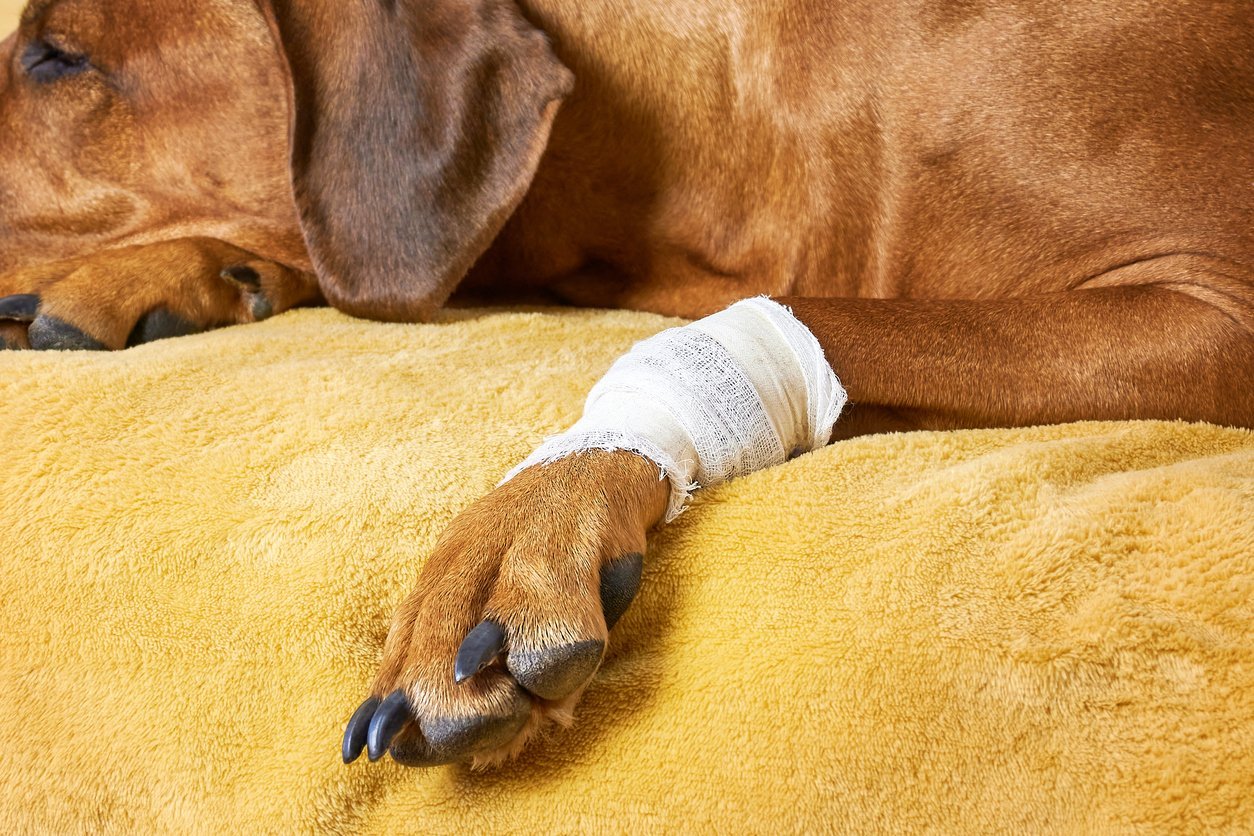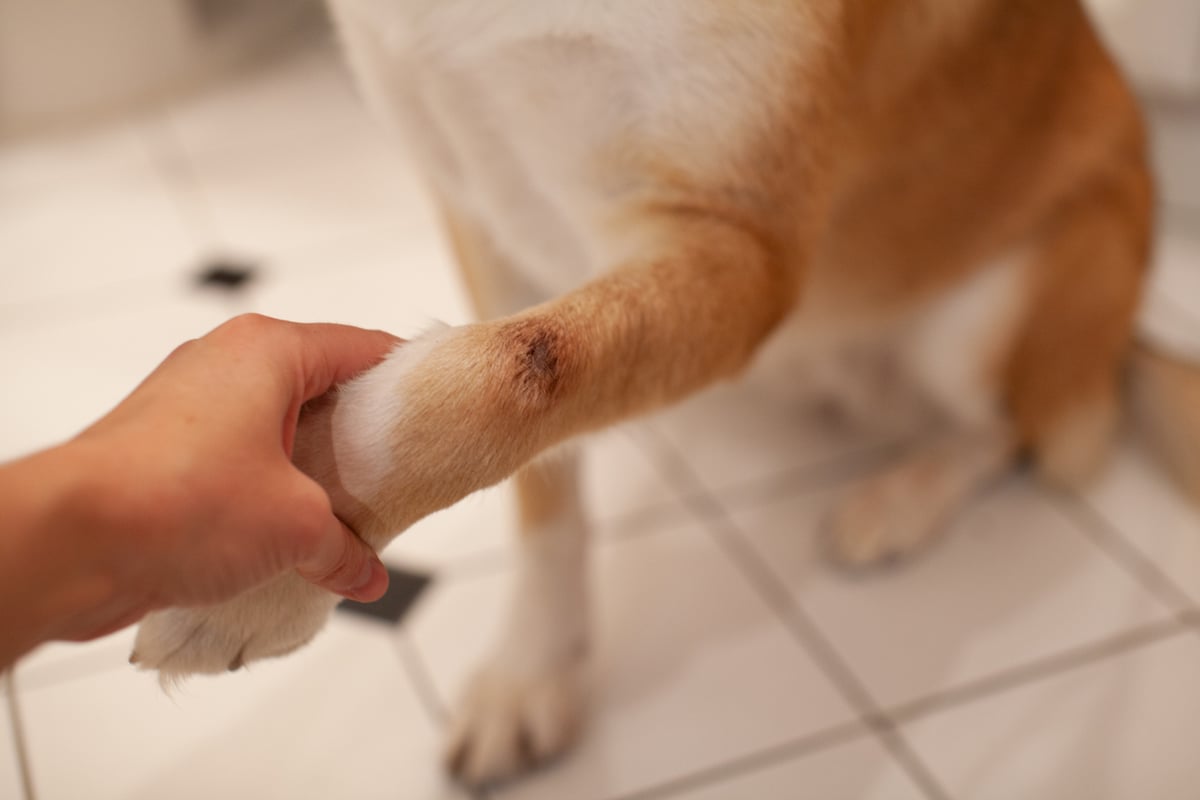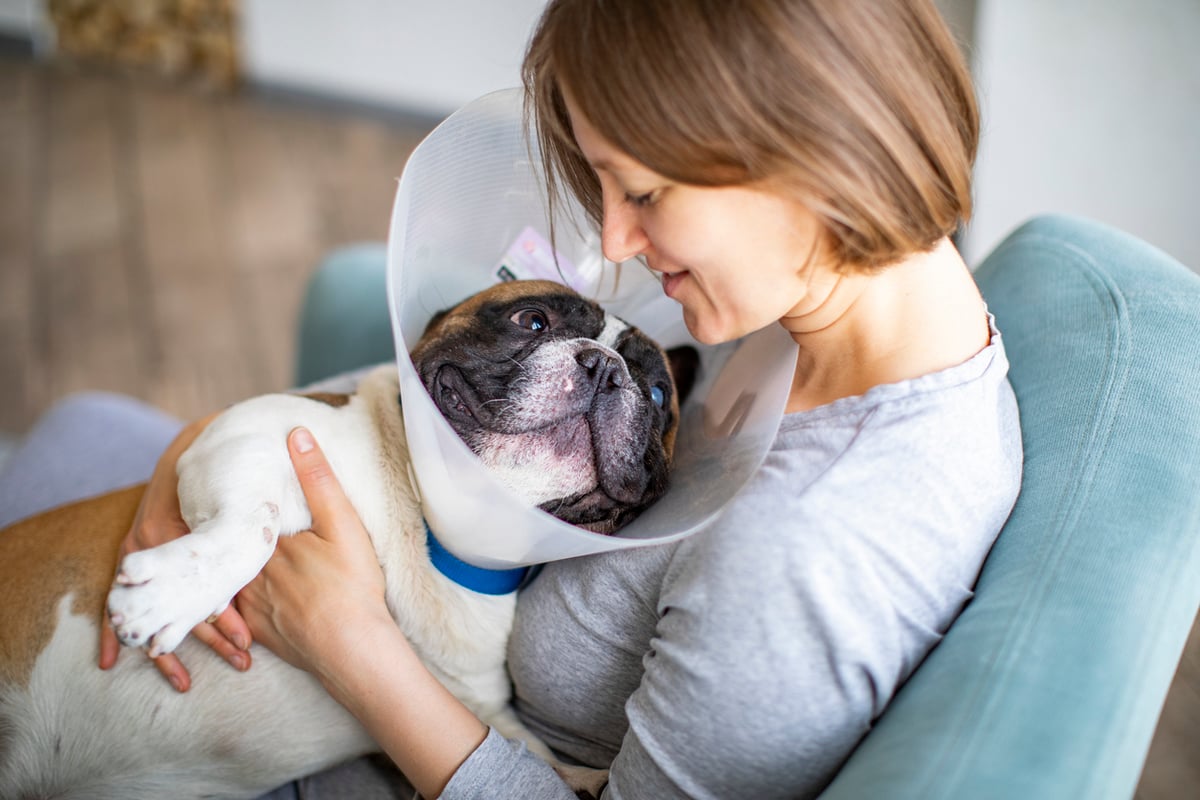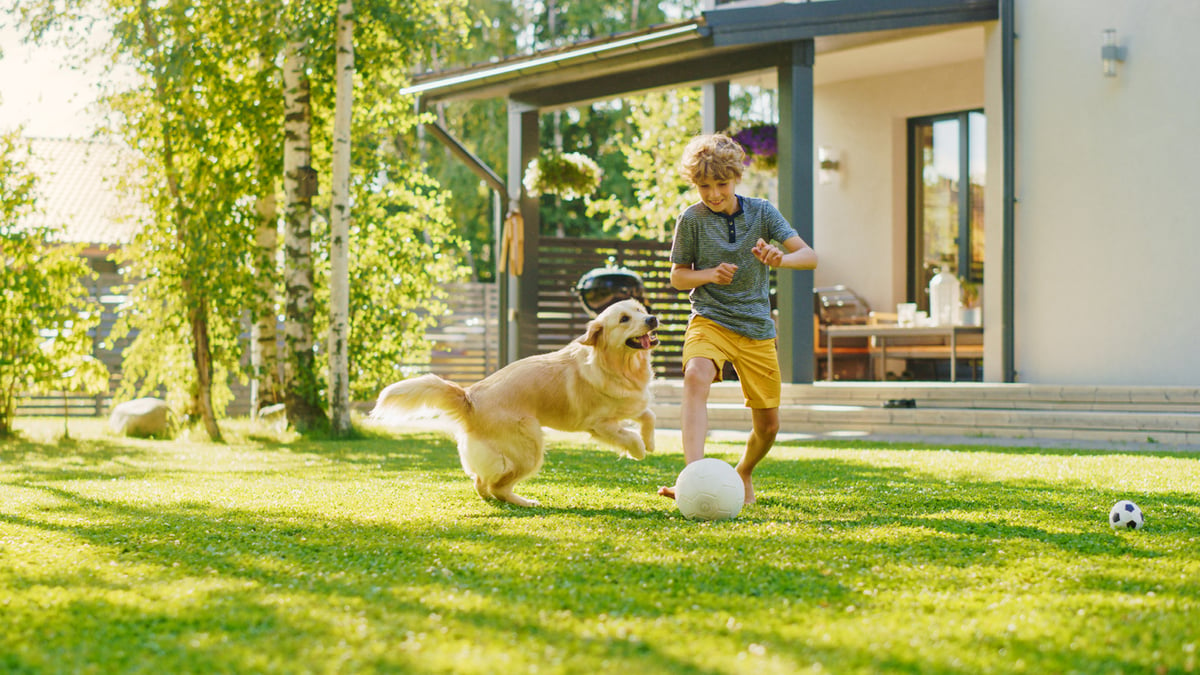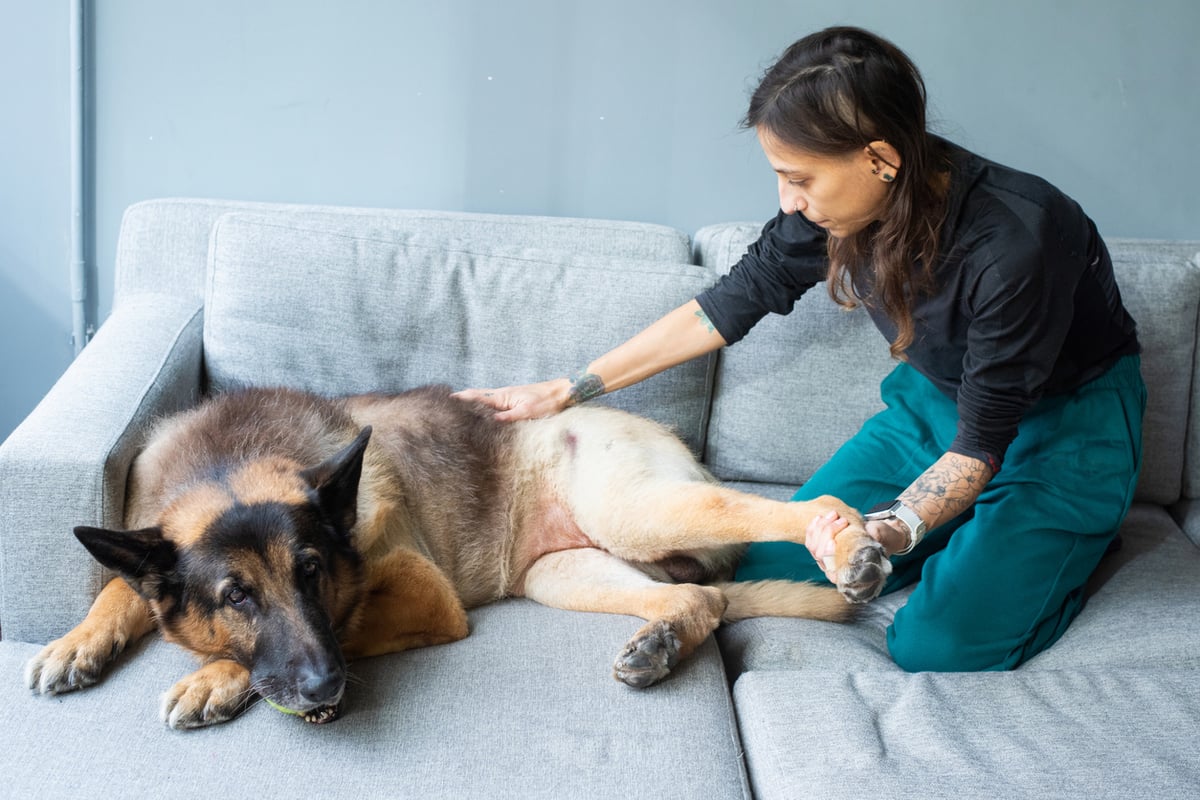Table of Contents
If you have a dog, you know how much they love to play. Spending an afternoon throwing frisbee at the dog park is a relaxing and fun event for you and your dog.
But what happens when they get a dog front leg injury?
No more fun for your pup.
Because of the critical role your dog’s forelimbs, or front legs, play in their overall mobility, avoiding a dog leg injury significantly affects your dog’s mobility (and happiness).
In this post, we’re covering everything from prevention to treatment to recovery from a dog front leg injury.
So leg’s get into it!
Dog Leg Injury Symptoms
The first step to healing a dog leg injury and other leg-related dog mobility concerns is spotting them
When you’re worried about your dog having a dog leg injury, look for these symptoms:
- Gait changes
- Swelling
- Bruising
- Sudden aggression
- Lameness
- The affected limb is hot to the touch
- Weakness
- Joint range of motion is impaired
- Reluctant to rise from laying
While these are the most commonly spotted signs of a dog leg injury, you know your pup best. Anything out of the ordinary in their behaviour, including changes in their eating habits, bathroom habits, or physical activity levels, are red flags to watch for.
Signs and Symptoms of a Dog Front Leg Injury
Knowing your dog has a leg injury is one thing, but they do have four of them — so how do you know which one is the culprit of their pain?
If you’ve got a dog front leg injury on your hands, you’ll notice two key behaviours:
- Your dog raises their head when their front legs touch the ground
- They lower their head when bearing weight on back legs
It will also be harder for them to run or get up from a resting position. If you spot their limb dangling, that could be a serious break, meaning you should contact your vet immediately.
Dog Can't Put Weight On Front Leg
When a dog can’t put weight on their front legs, it is usually due to injury or trauma. With mild injuries, your dog should be able to bear some weight on their injured front leg.
According to the American Kennel Club, If your dog cannot bare any weight on their front leg, it is likely due to one of the following:
- Broken bone
- Fracture
- Ligament tear
- Spinal injury
Dog Swollen Front Leg
A number of factors beyond trauma and injuries can cause a dog swollen front leg. Swelling is an inflammatory response that allergies, infection, immune disorders, and injury can cause.
The five characteristics of inflammation on a dog front leg injury are:
- Swelling
- Heat
- Pain
- Redness
- Loss of function
Dog Hind Leg Injury Symptoms
When looking for dog hind leg injury symptoms, it goes without saying that your focus will be on their hind legs.
Watch for these two telltale signs when you’re observing your pup as they move:
- They compensate for pain in the back legs by leaning forward and shifting weight frontwards.
- The tail or affected rear leg will rise when coming in contact with the ground
Common Causes of a Dog Leg Injury 
When you have a suspected dog leg injury on your hands, it only makes sense you want to know what caused it.
But before you get to the root of the problem with your vet, you should first ask yourself if the pain is acute or chronic.
Why does it matter?
Acute pain is when your pup suddenly begins to show signs of injury. They may have started limping in the last few minutes or hours, and it appears to have improved within a few days alongside rest and pain relief such as NSAIDs or cold compresses. If rest doesn’t help with your pup’s limp or hind leg injury symptoms, you will want to call the vet.
However, chronic leg injuries are when symptoms last longer than a day or two and continue to be a problem for your pup. Chronic injuries can be due to age-related diseases like arthritis or genetic conditions like hip dysplasia.
With that in mind, you can consider the causes of your dog leg injury — and there are plenty of potential causes to consider.
Often, our pups can get into a bit of trouble when they are having too much fun, and that’s when common strain and sprain injuries occur. Other times, you are enjoying a walk, and your poor companion gets a cut on their paw.Or sometimes, injuries occur because of age-related wear and tears or genetic conditions inherited by your pup.
The table below outlines some of the most common causes of a dog leg injury that pet pawrents should be aware of and what to look for in each.
| Dog Leg Injury |
Injury Information |
| Ligament Strain Injury |
|
| Sprain/ Dog sprained front leg or back leg |
|
| Fracture or Break |
|
| Tear |
|
|
|
|
|
|
|
|
|
| Cruciate Ligament Rupture |
|
| Dislocation/Dog dislocated front leg or back leg |
|
| Laceration |
|
| Nail Problems |
|
Other Types of Dog Injuries
You want to make sure you know the signs of your dog’s distress from any injury.
And the thing is, your pup may show signs of a dog leg injury, but another part of their lower limb or body is hurt, like their wrist or shoulder.
That’s why it’s important to understand your dog’s anatomy enough to see what could be the real problem. Check out the diagram below for an idea of where key joints in their lower limbs are located.
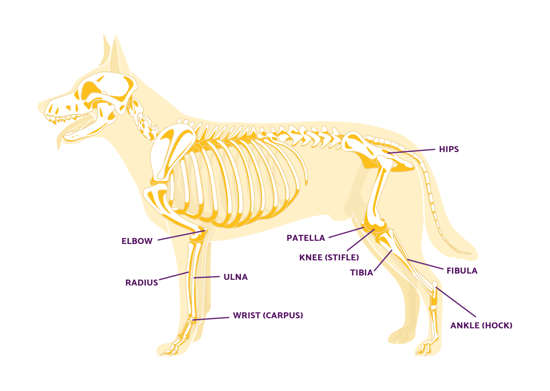
Now that we’ve got our quick anatomy lesson out of the way, let’s get into what kinds of other dog injuries to watch for.
Dog Knee Injury
Dog knees, also known as the stifle joint, are critical to your dog's movement.
Like our own knees, dog knees also bear the brunt of your dog’s weight when in motion. That’s why it’s common for your pooch to sustain a dog knee injury, especially in very active dogs.
The two most common dog knee injury types are a torn CCL or luxating patella. Other common dog knee injury problems are related to the ligaments that support their knee.
Dog Shoulder Injury
Dog shoulders are less mobile than our own, allowing their legs to power forward while in motion, with limited side-to-side motion.
Though they may be less mobile joints than our shoulders, a dog shoulder injury can harm your dog’s mobility.
Common kinds of dog shoulder injuries include:
- Supraspinatus tendonitis: tears or tendonitis associated with the supraspinatus tendon
- Bicipital tenosynovitis: a slow tear in shoulder tendon over time
- Medial shoulder instability: a type of repetitive strain injury common in agility dogs
Dog Nail Bed Injury

Three parts make up a dog’s nail bed — the bone, the quick, and the nail itself. The nail is made of keratin, forming a protective, hard layer around the quick.
Trauma is the most common cause of a dog nail bed injury; it often involves a fracture or involving fracture or complete avulsion (ripping out) of the nail from the nail bed. When the trauma affects the vascular portion of the nail, it can lead to bleeding, swelling, and infection causing pain.
Avoid a dog nail bed injury by ensuring your dog’s nails are trimmed, but not too closely. You should only be cutting the hard, dry keratin nail. If you’re in doubt, leave the trims to a professional to escape a further dog nail bed injury.
Dog Wrist Injury
Wrists do a lot for humans; the same goes for our doggy companions.
Dog wrists are prone to injuries like us too, particularly strains (affecting tendons) and sprains (affecting ligaments). This can happen when your pup jumps down from a height like a car or bed and lands hard.
Your dog can often recover from a mild strain or sprain with rest and the help of a brace to support the joint while the tendons or ligaments recover.
Dog Spinal Injury
Spinal trauma in dogs is defined as damage to the spinal cord causing ongoing issues and pain. Dog spinal injuries account for roughly 2% of dog injuries brought to veterinarians.
Types of dog spinal injuries are broken into three categories:
- Intervertebral disk disease- aging vertebrae that harden, causing pain or paralysis.
- Trauma- car accidents, major falls, and severe bite wounds.
- Blood supply being blocked to the spinal cord- Usually caused by a blocked artery.
There are a few conditions that relate to a dog spinal injury:
- Intervertebral disc disease (IVDD)
- Fibrocartilaginous embolism
- Discospondylitis
- Wobbler’s Syndrome
- Lumbosacral degeneration
Many of these conditions, while serious, can be helped with a combination of surgery and physical therapy to improve the dog back injury recovery time.
Dog Hip Injury
You’re probably already hip to the fact that your dog’s rear limbs rely on the hips to move, making them pretty important.
You may not know, however, what kinds of problems can befall this key pair of joints. Hip dysplasia is probably the most common dog hip injury overall but is even more common in large or giant breed dogs.
Other types of dog hip injuries include:
- Strains
- Sprains
- Arthritis
- Dislocation
Dog Elbow Injury
A dog elbow injury is no fun.
Your dog needs their elbow to be able to run, jump, and play and a dog elbow injury can slow them down. The good news is we can utilize plenty of options to help our pups feel their best in conditions like elbow dysplasia or a torn ligament.
Depending on the severity of your case and what’s at the root of the issue, your vet may recommend treatment as mild as some rest and as serious as surgery.
Either way, your vet knows best and can tell you what the best move is for your pup. They may suggest braces or supports while your dog heals and other ways to help them recover more quickly. Adding in an extra-strength joint supplement like TRI-ACTA H.A. can help them get greater mobility back to their elbows in no time.
TRI-ACTA H.A. includes ingredients such as glucosamine and chondroitin, which helps strengthen your dog’s joints by helping to repair and maintain cartilage. MSM is a natural anti-inflammatory, helping to reduce swelling. Hyaluronic acid assists with joint lubrication, helping your dog be able to move freely and without pain.
TRI-ACTA H.A. for Pets
Our maximum strength formula is optimally designed to accelerate the formation of cartilage, minimize inflammation, expedite the healing process, and improve joint conditions.

Dog Front Leg Injury Prevention Tips
Prevention is always the best medicine in our books. That’s why we will share 5 tips for avoiding dog leg injury to help keep your dog happy and healthy next.
Balanced Nutrition for Your Dog
A balanced diet is very important in preventing a dog front leg injury, as well as other injuries.
By having proper nutrition, your dog is less likely to become obese. Obesity is a challenge for many dogs (who isn’t guilty of giving them an extra treat or two), and it can create many health problems for your pup simply because of the greater stress it puts on their bodies.
Your dog’s diet must include the following components:
- Fats
- Proteins
- Carbohydrates
- Water
- Minerals
- Vitamins
The good news is that commercial dog food and special diets like the raw food diet allow you to easily balance nutrition for your pup. You just have to ensure you skip giving those extra treats!
Incorporate Dog Joint Supplements
You shouldn’t be surprised that dog supplements are the best prevention in our eyes. After all, it’s all about helping protect your dog from the inside out.
Dog joint supplements can help your dog build strong joints so that the next time they have a dog back leg injury, they can recover from it quickly or avoid it in the first place.
But what makes a supplement such a superhero to your dog’s joints?
That would be thanks to the following powerful ingredients:
- Glucosamine
- Chondroitin
- MSM
When you have a joint supplement that includes all three of these ingredients, you’re setting your pup up for success. But don’t just choose any old supplement.
You need to choose a joint supplement that is easy to administer, has therapeutic benefits, and has high-quality ingredients you can trust.
TRI-ACTA for pets checks off all of those boxes and more. With essential ingredients like glucosamine, chondroitin, and MSM, TRI-ACTA is an excellent joint supplement that can be given to your pup from a young age as a preventative measure to maintain joint health throughout their lives.
TRI-ACTA for Pets
A proactive approach for developing and younger adult pets to maintain optimal joint health mobility, minimize inflammation and fend off age-related ailments.
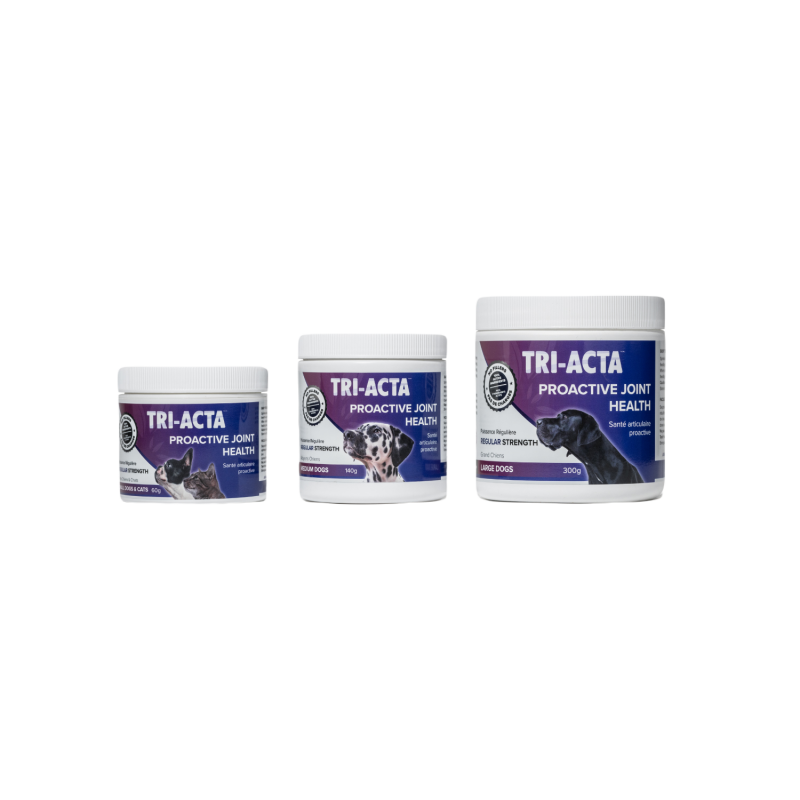
We even have a maximum strength formula, TRI-ACTA H.A,, offering your pup the bonus of hyaluronic acid to improve joint fluid viscosity. This formula is recommended for dogs that have existing joint conditions or have joint wear and tear due to age.
Both supplements are great options for protecting your pup from a dog front leg injury, depending on your pup.
Get Regular Exercise
We know how much better we feel as humans when we hit the gym more regularly, and the same applies to our dogs.
While you don’t need to get your dog to start hitting the leg press every morning, you can choose conditioning exercises that will help your dog fortify their joints by having strong muscles.
Some easy exercises to work into your daily routine include:
- Swimming
- Fetch
- Hikes
- Agility work
- Obedience training (sit and stay, and retrieval exercises)
- Walks or runs
Always work your dog up gradually to any kind of exercise. You wouldn’t run a marathon untrained, so don’t do the same to your pup. Similarly, consistency is key to success! Having a 30-minute walk every day would be better than one very long hike once per week. Finally, don’t forget to warm up and cool down to avoid your pup hurting their leg muscles.
Check for Hazards
When you’re out and about with your pup, you should always examine the environment where they are playing and walking.
Check for hazards like:
- Ice, snow, and extreme cold in the winter
- Hot pavement or surfaces in the summer
- Debris or garbage
- Uneven ground
- Areas with little traction
- Sharp objects (broken glass, wires, or metal fence)
- Terrain where the ground is not immediately visible (heavy brush, snow, foliage)
- Water
If you spot anything that you feel could be dangerous to your pup, trust your gut and check it out before allowing them to play or walk in the area.
Additional Safety Considerations
Last but not least, this tip is all about the general safety of your pup.
As we mentioned above, trusting your gut is key to good pet parenting. You need to use your common sense and as always, act with an abundance of caution. This is your fur child we’re talking about!
Here are a few things to keep in mind regarding dog safety:
- Paw and leg protection (waxes, boots, and braces) can be helpful for active pups and ageing seniors alike.
- Use appropriate toys designed for dogs only. Don’t use children’s toys or household items to play with your dog.
- Avoid playing when your dog is leashed.
- Wear a doggy life jacket to avoid overexertion and slips and falls around the dock and water.
- Ensure area rugs are used on smooth flooring where they may be allowed to jump up onto furniture like couches.
4 Dog Front Leg Injury Treatment Options
As much as we can try to prevent our pups from getting injured, you may find yourself with a dog front leg injury anyhow. That’s why it’s equally important to understand your dog's treatment options and help get them feeling better as soon as possible.
Dog Leg Brace for ACL Injury
A little support goes a long way, so they say.
That is true of dog leg injury. Adding a brace to support your dog’s ACL (also called the CCL) during recovery from injury is a great way to help keep them mobile but also safe from further injury.
Benefits of using a dog leg brace for ACL injury include:
- Helps hold limbs in a normal walking position
- Provides support to torn, stressed, or strained muscles
- Stabilizes the limb while in recovery
- Less immobile than a cast
- Easy to use and implement at home
- Customizable to the needs of your dog
Always speak with your vet before trying any supports like dog leg brace for ACL injury in case your dog needs medical intervention.
A leg brace or dog hip brace can significantly reduce the recovery time of front leg injuries in dogs.
Surgery
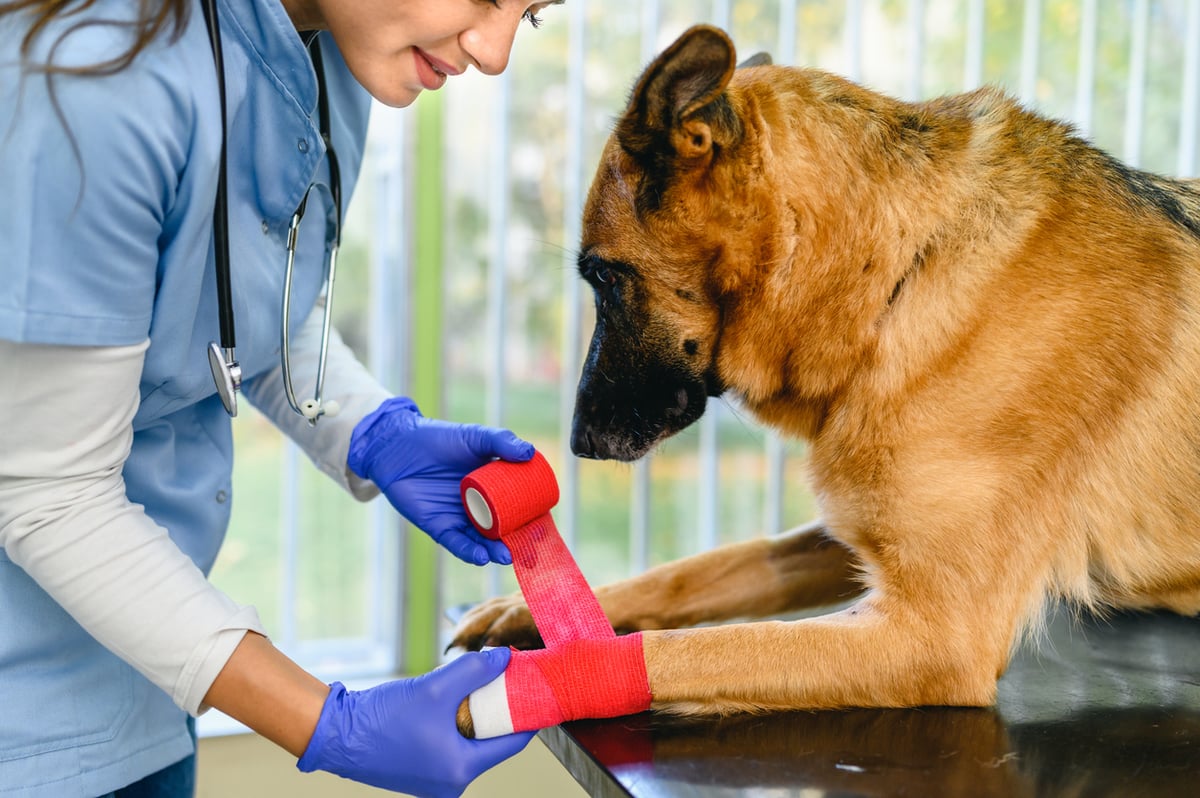
There are numerous surgical procedures that vets can use to correct a dog leg injury.
Depending on the part of your dog’s front leg or other legs that are injured, your vet will choose a surgery that suits the severity and location if surgery is the best option for your dog’s particular needs.
In general, the types of surgery for a dog front leg injury include:
- Cruciate ligament repair: surgery to repair torn or damaged CCL ligaments in the knee.
- Patella surgery: surgery to repair patellar luxation or patellar deformities in the knee.
- Wound repair: surgery or stitches to repair broken skin.
- Broken bone repair: surgery to repair a broken or fractured bone.
- Hip surgery: surgery to repair hip dysplasia.
- Bone deformity condition correction: any other surgery to repair a bone or joint that has not formed appropriately, like elbow incongruency.
Your vet will work with you to create a treatment plan that is right for your pup and provide you with the best option for helping your dog feel their best.
Physical Therapy
After surgery, or for more moderate cases of a dog front leg injury, your vet may recommend various kinds of physical therapy.
Most of the time, these are performed by professionals in a dedicated facility or clinic.
Some professional rehab therapies your dog may benefit from include:
- Cryotherapy: Use of cold to target a sore area and reduce inflammation
- Hydrotherapy: Water is used to achieve weightlessness on joints
- Massage therapy: A professional canine massage therapist can manipulate the sore and relieve pain
- Physiotherapy: Exercises are performed to strengthen muscles and joints
You can translate some of that professional rehabilitation to home care in addition. Adding ice or hot packs to your dog’s daily routine can help ease inflammation and pain, and trying alternative exercises like swimming instead of walking can also help ease the pain.
Joint Supplements for Dog Front Leg Injuries
When your pup is down for the count with a dog front leg injury, you want to see them feeling their best as soon as possible.
And adding a maximum-strength pet supplement to your recovery plan is a great way to accomplish just that.
Joint supplements are not only great at helping prevent a dog injury but also when recovering from it. They can help the most crucial part of your pup’s joints, the cartilage, heal faster and ensure greater joint mobility in the joint itself.
Just how do they do that, exactly?
The key ingredients found in high-quality, maximum-strength dog joint supplements like TRI-ACTA H.A. make the healing happen, as outlined in the table below.
| Ingredient in TRI-ACTA H.A. for pets |
Benefit |
| Glucosamine |
Repairs joint cartilage |
| Hyaluronic Acid |
Improves the viscosity of a synovial (joint) fluid |
| MSM |
Reduces pain and inflammation within the joint |
| Chondroitin |
Prevents the cartilage from further breakdown |
Not to toot our own horns too hard, but we also offer a small yet therapeutic dose that’s easy to sprinkle into your pup’s meals, and we have the backing of third-party lab testing to make sure your pup gets the quality they deserve. You can even serve TRI-ACTA H.A. for Pets to your ageing or injured kitties, too (in the appropriate smaller dose).
TRI-ACTA H.A. for Pets
Our maximum strength formula is optimally designed to accelerate the formation of cartilage, minimize inflammation, expedite the healing process, and improve joint conditions.

Considerations During Recovery
No matter what treatment option you seek or how long the road to recovery may be for your dog, there are some key things to keep in mind.
Here are some of our most important considerations during recovery from a dog front leg injury:
- Limit exercise but remain mobile (as directed by your vet).
- Use a supplement like TRI-ACTA H.A. for maximum joint health protection and speedier recovery.
- Make sure your home is mobility friendly (use gates to close off stairs, add a rug on slippery floors, and get a ramp to avoid them jumping up).
- Apply cold compresses for swelling.
- Create a soft space for your pet to rest in with extra padding to support their limbs.
- When in doubt, ask your vet what to do! They know your pet and their health best and can offer professional advice.
FAQ
Why is my Dog Faking Leg Injury?
Dogs sometimes over-exaggerate their leg injuries to get affection from their owners. We know that dogs are incredibly intelligent creatures, and research suggests that dogs faking a leg injury is a learned trick over time. There’s no real evidence behind why dogs like to fake a leg injury, but it is believed that they may want their owners to care for them or give them special attention; including treats!
How Do I Know if My Dogs Leg Injury is Serious?
If your dog is limping and unable to bear weight on their limb you should take them to a vet for an examination. If you suspect your dog’s leg injury is severe, you should take them to a veterinary emergency room. Some signs that a dog leg injury is severe include:
- Dangling limb
- Heat and swelling
- Bleeding or open wounds
- Obvious break or dislocation
- Dog can't put weight on front leg
What is the Most Common Front Leg Dog Injury?
A sprained wrist is one of the most common front leg dog injuries. Located on the foreleg below the elbow, a dog’s wrist and knees are more prone to sprains in the ligaments, whereas strains are more common injuries in the muscles or tendons around the hips and thighs. Sprained wrist dog front leg injuries are typically caused by hard landings, rough play, or strenuous exercise.
How Long Should It Take for Dog Leg Injury to Heal?
Depending on the type and severity of the injury, it can take a few days to several weeks to heal. A dog can recover from minor sprains within a few days with adequate rest. Most soft tissue injuries take two to four weeks to fully heal. Broken bones take at least eight weeks to heal and require a proper treatment plan advised by a veterinarian.
Do Dogs Have Knees in Their Front Legs?
Like humans, dogs have two knees located on their rear legs. The joints in their front legs that look similar to knees are elbow joints, and the lower joints are wrists.
Start Preventing Dog Front Leg Injury
That’s it! Everything you need to know about a dog front leg injury.
We hope to have given you a leg up in protecting your precious pup from a dog front leg injury!
And don’t forget the one thing that will help your dog through the stages of prevention, treatment, and recovery — TRI-ACTA for pets, and our maximum strength formula, TRI-ACTA H.A. for pets. Our formulas contain glucosamine for dogs, and a host of other helpful joint-supporting ingredients, and the quality assurances you want to see for your furry family member.
You can find out where to buy TRI-ACTA and check out our blog for more helpful pet health information.
Newsletter Signup
Subscribe to our newsletter to receive the latest news and exclusive offers.
.jpg?height=2000&name=Cliick_Integricare-DISPLAY-REVISEDV2%20(1).jpg)
Proactive & Therapeutic Joint Supplements
When given daily, Integricare joint supplements recover bone and joint injuries faster and help prevent mobility injuries from happening in the first place.

